| Pages:
1
..
3
4
5 |
motoged
Elite Nomad
     
Posts: 6481
Registered: 7-31-2006
Location: Kamloops, BC
Member Is Offline
Mood: Gettin' Better
|
|
Whatever 
Don't believe everything you think....
|
|
|
JoeJustJoe
Banned
Posts: 21045
Registered: 9-9-2010
Location: Occupied Aztlan
Member Is Offline
Mood: Mad as hell
|
|
I would love to read David K's book, and it looks like he put in a lot of work into this subject, and he should be proud of his work.
I don't mind a little sugar coating of history, in regards to Baja history, the missions, Jesuits,Franciscan monks, or even Columbus, but as the years
go on the alternative views, from the Latin Americas perceptives should be put out there starting in High School, and the older history books should
be retired if they are not updated.
For example, Christopher Columbus, is not celebrated in Latin America, like he is in the USA, and even in the US, we are moving away of treating him
like an explorer hero, and many see Columbus, as an evil villain.
Here is a good article from the "Guardian" that's an respectable news outlet, and the article doesn't pull any punches, and shows Jumipero Serra, as a
conflicted man, who seems to care for the native Indians, but he also brutalized the Indians, through his own arrogance and ignorance, for example
locking up the natives for supposedly their own protection, but it turn out Serra's action caused the Indians to be infected with diseases.
______________________________________
Junípero Serra's brutal story in spotlight as pope prepares for canonisation
Many have condemned decision to elevate 18th-century missionary to sainthood after violence suffered by Native Americans he was said to be protecting
Generations of American schoolchildren have been taught to think of Father Junípero Serra as California’s benevolent founding father, a humble
Franciscan monk who left a life of comfort and plenty on the island of Mallorca to travel to the farthest reaches of the New World and protect the
natives from the worst abuses of the Spanish imperial army.
Under Serra’s leadership, tens of thousands of Native Americans across Alta California, as the region was then known, were absorbed into Catholic
missions – places said by one particularly rapturous myth-maker in the 19th century to be filled with “song, laughter, good food, beautiful
languor, and mystical adoration of the Christ”.
What this rosy-eyed view omits is that these natives were brutalized – beaten, pressed into forced labour and infected with diseases to which they
had no resistance – and the attempt to integrate them into the empire was a miserable failure. The journalist and historian Carey McWilliams wrote
almost 70 years ago the missions could be better conceived as “a series of picturesque charnel houses”.
read the rest here:
https://www.theguardian.com/world/2015/sep/23/pope-francis-j...
|
|
|
ELINVESTIG8R
Select Nomad
      
Posts: 15882
Registered: 11-20-2007
Location: Southern California
Member Is Offline
|
|
Quote: Originally posted by DaliDali  | Quote: Originally posted by motoged  | It is insanity to NOT learn from our history. If not accurately representing history in reporting it....what is that about?
Any comments are not a personal attack on DK, but perhaps on an approach to selling history.
No one wants history to be changed....just accurately reported.
[Edited on 6-27-2018 by motoged]
[Edited on 6-27-2018 by motoged] |
We have learned from history Ged.....the invaders of 300 years ago don't invade anymore.
This is one person's account, based on his research, of how it all went down and drawn from those on the ground at the time.
If your all wound up on getting it "accurate".....research and write your own published version. What's that all about?
It is impossible to dig into someone's head who trod the Baja 300 years ago and "accurately" make a call about their real intentions.
It's only from an opinion of some that there were indeed......dastardly in those intentions or not.
Yes you were very "submissive" and contrite.....if not down right snarky.
All because your slant on DK's political held views does not mirror your own. You know it....I know it.
Not a personal attack?.......pifff
|
Well said DaliDali. It's all a personal attack don't let anyone tell you otherwise. I see
you already don't. Great!
|
|
|
paranewbi
Senior Nomad
  
Posts: 913
Registered: 4-15-2011
Location: San diego
Member Is Offline
|
|
OH MAN!
This is SO better than TV
|
|
|
JoeJustJoe
Banned
Posts: 21045
Registered: 9-9-2010
Location: Occupied Aztlan
Member Is Offline
Mood: Mad as hell
|
|
I found this passage in David K,'s book, most interesting about lazy male Indians, sitting around like male Lions, scratching their private parts,
while the Indian women, compete with other Indians wives, gaining favor with their Indian Husbands.
I'm not going to say David K's, book, or research he did was wrong, because I'm sure other History books, share the same narrative. But if you ask me,
that narrative comes from a white man's narrative, a Jesuit narrative, an ultra conservative narrative, and from a Historians native, that would be
different from a historian in Latin America, or from other fields like science that would see Indian polygamy as a way for survival of a group of
people.
It's obvious the Jesuits, who were paternal were outraged over the Indians before, especially in regards to marriage, sexually, and spiritually. And
by God, they were going instill a fear of God, into these Indian heathens.
If you ask me these Pericu Indians, and basically most Indian tribes, were a lot more progressive than the sexually uptight Jesuits priests. The
Indians who saw sexually on a continuum like most modern psychologists do today. Marriage was not like it was for the Spanish, or in the US/Mexico.
There is no big marriage ceremony for these Indian woman, they hooked up with who they wanted, and didn't always stay with one man. The Spanish
soldiers really enjoyed how sexually open these female Indians were. Unfortunately, the Spanish soldiers spread a lot of early STDs back then.
So at the end of the day, I find the passage by David K, below, ,somewhat limited of what was really going on, and it's from an American frame of
reference. However, I also understand, the focus of the book was on the missions, and not Indians, lifestyle, marriage, and sexually.
________________________________
From David K's book:
David K wrote:"A major issue the Jesuits had with converting the natives to Christianity was the habit of the men of having several wives.
Padre Tamaral, wrote of the issue to the missions benefactors Marques de Villapuente, on June 15, 1731. Tamaral describes on the wives compete with
one another to gather the most food while their husbands rest all day in the shade with no need to work. Tamaral believed that by only halting
polygamy was there any hope of to get some work performed by the "lazy men." Since Pericu women outnumbered men polygamy was desired by the women for
survival of the all important family group."
_______________
A Brief History of Los Cabos, Part I: The Mystery of the Pericúes
Shelvocke was much more impressed with the moral qualities of the Pericú than Jesuit missionaries, who founded the first
missions in the area during the next decade. The Jesuits were intent on saving souls, and found the religion of the Pericúes–shamanistic, with
supernatural cures and distinctive burial practices–antithetical to their own. They had their own creation myth, in which heaven and earth created
by a god named Niparaja. And they were polygamous.
http://www.loscabosguide.com/a-brief-history-of-los-cabos-pa...
______________________
Native American Marriage ( highlights from this article)
The debate over marriage in American society and the fears expressed by some conservatives that allowing diversity will somehow destroy the
institution of marriage has been interesting (at some times amusing) to watch. While there appear to be some who feel that there is only one kind of
marriage, in reality there are many options regarding marriage. In order to provide some additional depth to an understanding of the complexity of
human marriage, I would like to discuss traditional Native American marriage.
In American society, part of the discussion about marriage is really about sex. While sex was a part of traditional Native American marriage, marriage
was not about sex. Prior to marriage, young people were expected to engage in sexual activities. Sex was not confined to marriage.
The Europeans, and particularly the missionaries, had a great deal of difficulty in understanding that women had power in Indian society and that they
had the right to sexual freedom. Indian societies were not organized on the patriarchal, monogamous norms of European society. Christian missionaries
were deeply shocked and offended by the fact that Indian women were allowed to express their sexuality. At the same time, many of the European men
were delighted by this.
Among some contemporary American commentators, there is a view that there are only two genders: male and female. Yet, in American Indian cultures
people did not make this an either/or situation. They viewed gender (and sexuality) as a continuum. Many modern Indians talk about a third sex/gender
often called a berdache or two-spirit. Yet in traditional cultures, it wasn’t quite that simple. There was a recognition of the feminine and
masculine in all people. There was not an either/or concept of being heterosexual or homosexual.
Traditional Native American cultures tended to be egalitarian: all people were equal. This is one of the things that bothered many of the early
Christian Missionaries, particularly the Jesuits in New France, as they viewed marriage as a relationship in which the woman subjugated herself to the
man. In Indian marriages, men and women were equals.
http://nativeamericannetroots.net/diary/1084
[Edited on 6-28-2018 by JoeJustJoe]
|
|
|
SFandH
Elite Nomad
     
Posts: 6925
Registered: 8-5-2011
Member Is Offline
|
|
Remember, the only people who can change the past are historians.
|
|
|
JoeJustJoe
Banned
Posts: 21045
Registered: 9-9-2010
Location: Occupied Aztlan
Member Is Offline
Mood: Mad as hell
|
|
The e wrote:"AND NEEDS TO BE CHALLENGED!"
So go ahead and challenge what was written or linked by me.
Otherwise, I'll continue to ignore you in the main area" of BN, like all the other members are doing with your posts.
|
|
|
David K
Honored Nomad
        
Posts: 64480
Registered: 8-30-2002
Location: San Diego County
Member Is Offline
Mood: Have Baja Fever
|
|
Back to the subject...
Another book that will make some of you (who like to think the padres were all demons) smile might be Dave Werschkul's 2003 book... it is a combo of
history and a travel guide to the mission sites.

|
|
|
David K
Honored Nomad
        
Posts: 64480
Registered: 8-30-2002
Location: San Diego County
Member Is Offline
Mood: Have Baja Fever
|
|
The missionaries
One of the most time-consuming sections to research in my book (Baja California Land of Missions) was the lists of missionaries and where they were in
Baja over the years.
In each mission chapter, I have a list of the padres documented in service there, so it is location specific [see sample below]. In the back of the
book, I have an appendix for each Order (Jesuit, Franciscan, Dominican) with the padres listed alphabetically along with the years and locations they
were in Baja [see second sample below].
Because the data is incomplete and so many came to Baja, there are many gaps and years missing. As I say in the book's Preface, I hope this work
inspires future discoveries be made to fill in the blanks in the history.
Sample from San José del Cabo mission chapter:
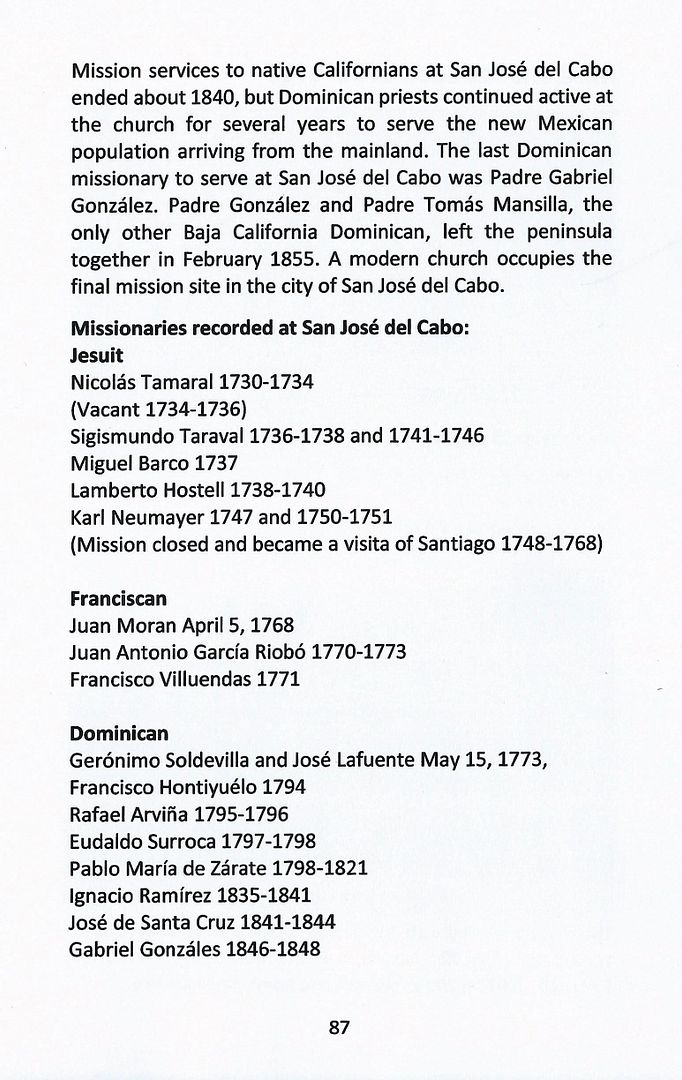
First page of Appendix B:

If you are interested in learning some of the past history of this exciting peninsula or would like to make more discoveries, I recommend my book to
get you started! www.oldmissions.com or any of the many distributors online or in stores. Discover Baja Travel Club has a fresh stock. Make sure you look for the
2018 (5th) Printing for the most recent, updated copies!
Want to see more photos and discuss or share more on the missions? Join my Facebook Baja Missions & Travel Group Page, Baja California Land of
Missions: https://www.facebook.com/groups/1685520784824763/
|
|
|
David K
Honored Nomad
        
Posts: 64480
Registered: 8-30-2002
Location: San Diego County
Member Is Offline
Mood: Have Baja Fever
|
|
I was having some email exchanges with Juanita of San Ignacio, who loves Baja books and Baja history like I do!
Sometimes small details that could be important are not always clearly revealed in reading the standard books.
For my 3rd Edition revision of The Old Missions book, I wanted just a bit more of the basic, important dates to be included and that was when the
stone churches were constructed.
San Ignacio mission church, for example, began as a hut made of sticks and grass. Eventually, adobe bricks were made. As fantastic a location as San
Ignacio and a few others were, large cut-stone block churches were built to replace the adobe buildings.
At San Borja, the adobe church ruin is preserved next to the stone mission that replaced it. Santa Gertrudis, San Ignacio, Mulegé, Loreto, and San
Luis Gonzaga, we only have the newer stone mission to see.
The basic San Ignacio history tells us the stone mission at San Ignacio was started by the Jesuit Padre Rotea about 1761 and of course the
construction was interrupted after 7 years when the Jesuits were arrested and removed from the Western Hemisphere in 1767-1768.
The Franciscans re-occupied the Jesuit missions, did some building (like the church at Mission Santa María) during the 5 years on the peninsula
before moving on to Alta California and handing over the peninsula to the Dominicans in 1773.
The Dominicans were credited with completing the giant church at San Ignacio in 1786. But when did they re-start the building?
Today, digging into the great books by Dunne, Sales, Baegert, and Engelhardt, plus checking in with Harry Crosby's research, we now know that Padre
Gómez, who arrived in 1773, got to work on it in 1779 for 7 years to finish.
San Ignacio church, 7 years of Jesuit run construction and 7 years of Dominican construction to build.



[Edited on 8-8-2019 by David K]
|
|
|
Skipjack Joe
Elite Nomad
     
Posts: 8084
Registered: 7-12-2004
Location: Bahia Asuncion
Member Is Offline
|
|
I would include in your book the population numbers and the maps 4x4abc provided in the link. Regardless of the morality issues these missions were
built to convert the natives and any numbers provided on their presence would be an aspect of primary importance. So I support fully 4x4abc's
recommendation as an addition to your book.
|
|
|
David K
Honored Nomad
        
Posts: 64480
Registered: 8-30-2002
Location: San Diego County
Member Is Offline
Mood: Have Baja Fever
|
|
Thank you for your ideas, Igor.
Here again is the link from Harald (4x4abc): http://www.baja101.com/Nomad/Settlements.pdf
The co-author is Peter Gerhard, who provided the historical data for the Lower California Guidebook and later renamed Baja California Guidebook, with
editions and printings from 1956 to 1980. Howard Gulick was the map maker and road traveler for the book prior to 1975 when Walt Wheelock revised and
renamed it to include the new highway and other changes. It was and still is a magnificent resource for Baja travel and history. It was known as the
"Baja Bible" for many decades.
|
|
|
David K
Honored Nomad
        
Posts: 64480
Registered: 8-30-2002
Location: San Diego County
Member Is Offline
Mood: Have Baja Fever
|
|
Update:
Max Kurillo (88 years of age) wants to not get overloaded on big changes for a third edition. The new El Camino Real section I was originally going to
add will instead make up a new El Camino Real book Max has planned.
The data on the Baja missions as well as some photographs have been updated from the 2013 2nd edition.
I encouraged Max to have a new cover design with just one or two photos plus possibly changing the title a bit from the rather long, "The Old Missions
of Baja & Alta California, 1697-1834"
Here is the original cover from 2012 and a sample page:

2020 EDIT:
Here is the new edition, with a slightly different name:

[Edited on 10-21-2020 by David K]
|
|
|
fishbuck
Banned
Posts: 5318
Registered: 8-31-2006
Member Is Offline
|
|
Cool thanks
"A ship in harbor is safe, but that is not what ships are built for." J. A. Shedd.
A clever person solves a problem. A wise person avoids it. – Albert Einstein
"Life's a Beach... and then you Fly!" Fishbuck
|
|
|
David K
Honored Nomad
        
Posts: 64480
Registered: 8-30-2002
Location: San Diego County
Member Is Offline
Mood: Have Baja Fever
|
|
For further interest, the following website is an excellent display of the places named by the Native Indians on the peninsula. Maps plus the names
and where they are in today's terms:
http://www.sandiegoarchaeology.org/Laylander/Baja/index1.htm
Clicking on the thumbnail maps will enlarge them.
Here is a sample of the Cochimí map surrounding La Purísima (Cadegomó):
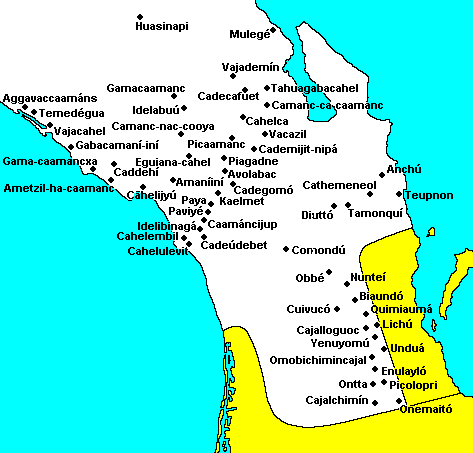
======================================================================
Additional reading: A survey of Native Baja California Indians by Edward Davis, originally published in 1926:
http://www.sandiegohistory.org/sites/default/files/journal/v...
|
|
|
David K
Honored Nomad
        
Posts: 64480
Registered: 8-30-2002
Location: San Diego County
Member Is Offline
Mood: Have Baja Fever
|
|
If you haven't yet, do see these great maps of Native place names. There are links for each tribe in Baja California here. Click on Databases/ Native
Place Names:
https://www.sandiegoarchaeology.org/Laylander/Baja/index1.ht...
Pericú

Guaycura
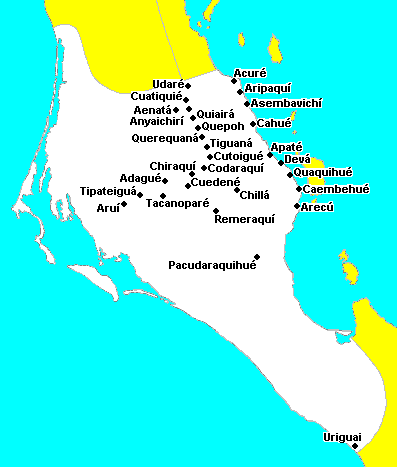
Monqui

Cochimí

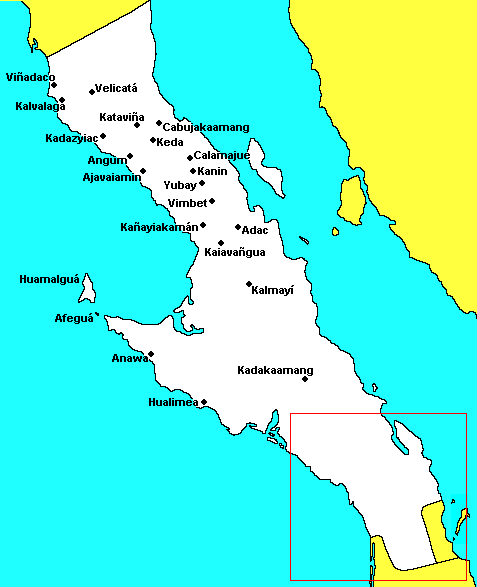
Kiliwa
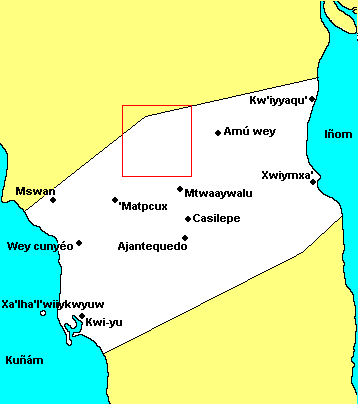
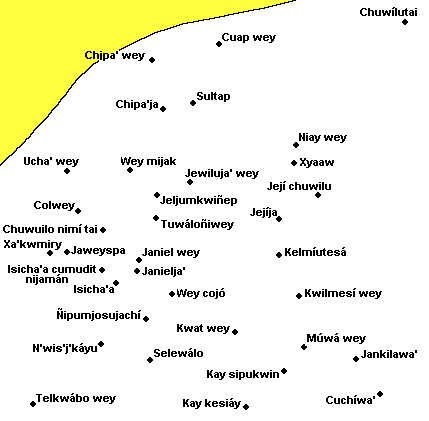
Paipai
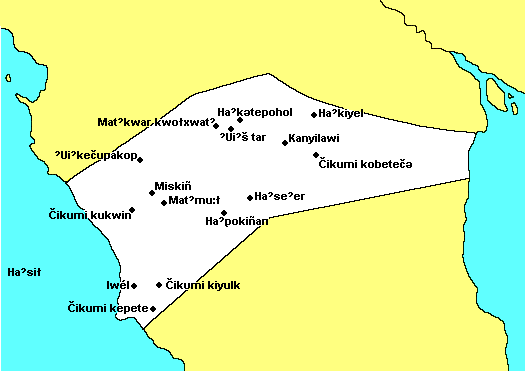
[Edited on 6-11-2019 by David K]
|
|
|
David K
Honored Nomad
        
Posts: 64480
Registered: 8-30-2002
Location: San Diego County
Member Is Offline
Mood: Have Baja Fever
|
|
Kumeyaay
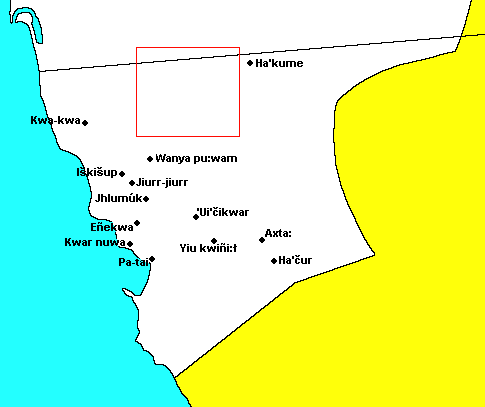

------------------------------------------------------------------------------------------------
Cocopa
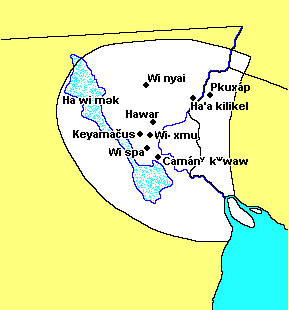
[Edited on 6-11-2019 by David K]
|
|
|
David K
Honored Nomad
        
Posts: 64480
Registered: 8-30-2002
Location: San Diego County
Member Is Offline
Mood: Have Baja Fever
|
|
An update!
We now have an exact date for the establishment of Mission Santa María, at the new site (moved from Calamajué, the first site): May 26, 1767.
Previously, we only had the month and year.
The data comes from a paper I just read:
La Misión de Calamajué: su historia, arqueología y entornos
by Antonio Porcayo Michelini
|
|
|
| Pages:
1
..
3
4
5 |
|

